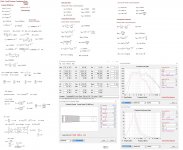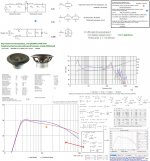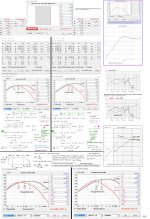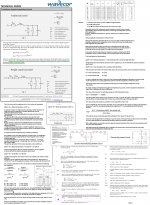I want to do a transmission line subwoofer box for my sundown nsv3 15 in my SUV. Partially because I want to hear a transmission line (I've heard subjectively they can sound quite nice) and partially to try something new.
Anyways the subs specs are as follows
re:3.8603
fs: 32.4712
qes:.5205
qms: 6.3275
Vas 64.1262 L
SD: 85633.55mm^2
CMS 61.5578 uM/N
le: 1.1243
PE: 2250
xmax is in the 32-36mm region, xmech is like 50mm or something crazy (it won't bottom easily), woofer is rated for 2250 RMS. (mine is custom) The mounting depth is quite extreme, at 13 inches! I would prefer subwoofer and port facing the rear of the vehicle. If that's not possible, sub facing back port to the side would be second best arrangment. Lasty, sub up and port to the rear also would work, but my response drops off sharply above 50hz when I do that ( I get near perfect cancellation at 60hz at the driver side headrest with subwoofer facing up)
The room I have to work with is 35wx30dx21h. (inches) I know that's probably pushing it space wise, but I'm hoping with a tapered design, something can be done still. Main octave of interest about 50-25hz. I'll be crossing the sub over around 60hz.
Can anything be done in such as space? thanks in advance
Anyways the subs specs are as follows
re:3.8603
fs: 32.4712
qes:.5205
qms: 6.3275
Vas 64.1262 L
SD: 85633.55mm^2
CMS 61.5578 uM/N
le: 1.1243
PE: 2250
xmax is in the 32-36mm region, xmech is like 50mm or something crazy (it won't bottom easily), woofer is rated for 2250 RMS. (mine is custom) The mounting depth is quite extreme, at 13 inches! I would prefer subwoofer and port facing the rear of the vehicle. If that's not possible, sub facing back port to the side would be second best arrangment. Lasty, sub up and port to the rear also would work, but my response drops off sharply above 50hz when I do that ( I get near perfect cancellation at 60hz at the driver side headrest with subwoofer facing up)
The room I have to work with is 35wx30dx21h. (inches) I know that's probably pushing it space wise, but I'm hoping with a tapered design, something can be done still. Main octave of interest about 50-25hz. I'll be crossing the sub over around 60hz.
Can anything be done in such as space? thanks in advance
Last edited:
Could you measure the approximate moving area? - looks like there's a lot of surround there, so Sd will be smaller than most 15"s.
Chris
Forgot to mention, mine has the high roll surround, so it's not as bad as the stock nsv3's in that dept.
sd is 85633.55mm^2 or 132.73 inches, whichever you prefer. I had sundown pull full t/s before it shipped to me.
Need Vas or Cms, spec'd Xmax, Pe also since each appears to be custom built; though preferably, 'we' would like the complete set of specs with design criteria both 'our' records as well as for cross checking specs that due to the vagaries of measurement procedures, software used, publication errors, can all too often be contradictory.
GM
GM
Need Vas or Cms, spec'd Xmax, Pe also since each appears to be custom built; though preferably, 'we' would like the complete set of specs with design criteria both 'our' records as well as for cross checking specs that due to the vagaries of measurement procedures, software used, publication errors, can all too often be contradictory.
GM
Vas 64.1262 L
CMS 61.5578 uM/N
Pe is powerhandling correct? The normal NSV3 is rated at 2500 RMS, mine has the NSV2 coil in it which is normally rated at 2000 RMS. It has a NSV2 coil because this sub has an aluminum sleeve along the pole, to lower inductance. That lowered motor force enough that unless I wanted a fairly high Q driver, I needed to go with a 8 layer coil. The nsv2 used a long 8 layer, so Jacob reccomended that unless I wanted a sub more suited toward a sealed alignment.
Jacob (sundowns owner) said the powerhandling would be between those 2 values since the extra motor cooling is part of the 2500 reccomendation for the NSV3, along with a slighly longer coil that I don't have. Sundowns rating are always conservative anyways, since car audio guys tend to put double rated on drivers. I told him I'd have a amp rated at 3800 watts at 1ohm on it and he said that would be no issue unless it was driven into clipping.
Xmax, he has never had this exact sub on a klippel, but knowing the same motor with the nsv3 coil was tested at 38mm, he estimated 32-36mm. Like I said, the sub has very large mechanical clearances, I've had as much as 3000 watts on it while playing music before, it's never shown any sign of mechanical distress while having it into that 30+mm region. Moves further easier and with less audible stress and distortion than my old AA Avalanche, if that's any indication. It's a 10inch spider a similar surround to what TC sounds uses on their long throw designs.
Last edited:
Hi All,
FYI, Op.s Driver in a T-TQWT:
b
That response looks more or less spot on for my personal preferences of what I usually aim for in a modeling program response! when looking to put in into a car. The dip between 40-50 filled in nicely as that's where my car contributes the most gain. Odds are that will play flat or need cuts well down to 20hz lol. Now the question is, can a enclosure with those specs be wedged into the shape I need!
Last edited:
Hi All,
FYI, Op.s Driver in a T-TQWT:
b
Any chance of translating this into a real world design? I've been reading up on horn resp to translate it, but indont have a computer that will run it at the moment.
The sim isn't accurate, it won't measure as the sim suggests. These large coil drivers never do. There is a way to improve the accuracy of the sim in Hornresp but it does not appear that Bjorno took advantage of it.
Are you referring to inducance based effects? This driver has a dual shorting rings and a full aluminium sleeve. Le is less than a third of re, and should be very well behaved over stroke
Last edited:
Are you referring to inducance based effects? This driver has a dual shorting rings and a full aluminium sleeve. Le is less than a third of re, and should be very well behaved over stroke
The specified Le in the first post is unbelievably low for a driver of this type. Not sure what to say. I definitely wouldn't build anything large or complex without testing it. If you could stick it in a sealed box or even on an OB (for that matter even just propped up with no baffle) and measure the response and compare to expected response you would know. If the measurement matches a sim it's good to go. If it's got any peaking or inductance humps where they are not supposed to be you need to account for that in your subsequent sims.
I don't think it's going to measure as a sim would indicate.
At the very least, can you measure t/s yourself and see what's going on with Le?
Hi All,
Agree with T3mpest regarding the Driver Z behaviour and if the Driver is measured before data is entered into HR and the difference TF between the simulated and measured is multiplied to the former:
The last FR graph would then please your Eyes...
I will not and haven't used the 'Large Voice Coil' feature as this feature should be placed at the Input Screen if to be believable.
 How to and Examples:
How to and Examples:
b
Agree with T3mpest regarding the Driver Z behaviour and if the Driver is measured before data is entered into HR and the difference TF between the simulated and measured is multiplied to the former:
The last FR graph would then please your Eyes...
I will not and haven't used the 'Large Voice Coil' feature as this feature should be placed at the Input Screen if to be believable.
 How to and Examples:
How to and Examples:b
Attachments
The specified Le in the first post is unbelievably low for a driver of this type. Not sure what to say. I definitely wouldn't build anything large or complex without testing it. If you could stick it in a sealed box or even on an OB (for that matter even just propped up with no baffle) and measure the response and compare to expected response you would know. If the measurement matches a sim it's good to go. If it's got any peaking or inductance humps where they are not supposed to be you need to account for that in your subsequent sims.
I don't think it's going to measure as a sim would indicate.
At the very least, can you measure t/s yourself and see what's going on with Le?
I cannot measure myself but can promise it's accurate. I have done a ported box and noticed no hf roll listening near field to at least 100hz. As i said the motor has 2 shorting rings and a full fairly thick sleeve. Even without the pole sleeve the driver using a 4 layer 80mm long coil has inductance slightly lower than le that was klippeled that's how the driver comes "stock". He has had one driver with sleeves on a klippel as well, same 80mm long coil as stock and with the sleeve to test its effectiveness and le was 1/6 're.
My coil is quite a bit thicker since it's an 8 layer, 74mm long as I wanted to bring back some of the lost bl but 1/3 ratio seems very consistent. Sundowns nsv3 platform is very versatile and this driver was built with both sq and output in mind.
My exact driver was tested before it left the shop, I'm pulling these specs directly off the pic of the computer screen he sent me of my exact one of a kind speaker. The sundown shop has a much better test setup than I do, so I trust their specs in This case.
This is NOT your typical car audio subwoofer. You can learn more about the sundown nsv3 platform here.. most car audio guys run them stock, but I'm not most guys, hehe
http://www.sundownaudio.com/index.php/products/subwoofers/item/ns-v3.html
Last edited:
Hi All,
Agree with T3mpest regarding the Driver Z behaviour and if the Driver is measured before data is entered into HR and the difference TF between the simulated and measured is multiplied to the former:
The last FR graph would then please your Eyes...
I will not and haven't used the 'Large Voice Coil' feature as this feature should be placed at the Input Screen if to be believable.
How to and Examples:
b
I see you underlined "there is not a big difference in low frequencies" in the Wright inductance paper. All you have to do is look through data-bass measurements of this type of driver to see that there are indeed massive difference in the low frequencies, especially with resonant enclosures like ported boxes and tapped horns. Sims don't match measurements with this type of driver.
If you want to use the input screen to account for large coil inductance effects you can do what I do - change Bl on the input screen. My sims match measurements much better than sims that do not account for inductance. Have you read my paper? I tested 22 drivers and compared to data-bass measurements. The adjustment works every time, even on tapped horns using this type of driver.
Last edited:
As for your first two attachments I have no idea what you are attempting to show, as usual there's a lot of numbers with no real explanation of anything.
I do however understand "Layman Eye Candy", a phrase you used quite a few times.
I invite you to show a simulation of a tapped horn with this type of large coil driver that comes even remotely close to a measurement. I have done this and presented my findings. If you are unable to do this I don't think you are on solid ground to call me a layman. Try the Othorn tapped horn with Mach 5 Audio UXL. Good luck with that. Let me know when you get a sim that's remotely close to what Ricci measured.
My proposed method is not perfect, it does have flaws but it allows you to get a simulation that will match a measurement much closer than without using it. I proved this when I simulated EVERY SINGLE MEASUREMENT that data-bass had with this type of driver and compared my sims to the actual measurement.
I do however understand "Layman Eye Candy", a phrase you used quite a few times.
I invite you to show a simulation of a tapped horn with this type of large coil driver that comes even remotely close to a measurement. I have done this and presented my findings. If you are unable to do this I don't think you are on solid ground to call me a layman. Try the Othorn tapped horn with Mach 5 Audio UXL. Good luck with that. Let me know when you get a sim that's remotely close to what Ricci measured.
My proposed method is not perfect, it does have flaws but it allows you to get a simulation that will match a measurement much closer than without using it. I proved this when I simulated EVERY SINGLE MEASUREMENT that data-bass had with this type of driver and compared my sims to the actual measurement.
Last edited:
I cannot measure myself but can promise it's accurate. I have done a ported box and noticed no hf roll listening near field to at least 100hz. As i said the motor has 2 shorting rings and a full fairly thick sleeve. Even without the pole sleeve the driver using a 4 layer 80mm long coil has inductance slightly lower than le that was klippeled that's how the driver comes "stock". He has had one driver with sleeves on a klippel as well, same 80mm long coil as stock and with the sleeve to test its effectiveness and le was 1/6 're.
My coil is quite a bit thicker since it's an 8 layer, 74mm long as I wanted to bring back some of the lost bl but 1/3 ratio seems very consistent. Sundowns nsv3 platform is very versatile and this driver was built with both sq and output in mind.
My exact driver was tested before it left the shop, I'm pulling these specs directly off the pic of the computer screen he sent me of my exact one of a kind speaker. The sundown shop has a much better test setup than I do, so I trust their specs in This case.
This is NOT your typical car audio subwoofer. You can learn more about the sundown nsv3 platform here.. most car audio guys run them stock, but I'm not most guys, hehe
Nightshade v.3
If you are sure then build Bjorno's design. I'd like to see a measurement someday if you get a mic.
When I don't see response, impedance plots, I assume the specs are questionable and they usually are, so look forward to some real data.
Really, I'm surprised that any mobile audio sub driver manufacturer would bother with low Le since it's usually advantageous to have the mid-bass hump and XO point is typically low enough not to be an issue.
GM
Really, I'm surprised that any mobile audio sub driver manufacturer would bother with low Le since it's usually advantageous to have the mid-bass hump and XO point is typically low enough not to be an issue.
GM
https://m.facebook.com/story.php?story_fbid=10207804900223020&id=1309987731
Here is a link to the spec sheet screen that was sent to me if it helps add any validity.
Anyways assuming the le is correct, how do I take his hornresp and translate it into an enclosure? Can someone ggive me the segment lengths and surface area of each sectjon? Not 100% on how to read it, at least not enough to try and design my 1st tine off it. If anyone with more experience is willing to do that legwork, or even draw it out that'd be much appreciated. I'm sure many of you can do it with considerably less difficultly.
Here is a link to the spec sheet screen that was sent to me if it helps add any validity.
Anyways assuming the le is correct, how do I take his hornresp and translate it into an enclosure? Can someone ggive me the segment lengths and surface area of each sectjon? Not 100% on how to read it, at least not enough to try and design my 1st tine off it. If anyone with more experience is willing to do that legwork, or even draw it out that'd be much appreciated. I'm sure many of you can do it with considerably less difficultly.
The owners of sundown audio is a sq guy and a bit of a speaker geek at heart. He is always pushing the limits of what can be done and has worked closely with Dan Wiggins and keeps in touch to get new ideas and feed off one another. For exapmple sundowns new surrounds have almost no cms change over stroke, at least compared to anything else on the market. They are capable of over 50mm one way excursion with no damage as well. His baskets are also his own tooling and offer even more clearance and strength than tc sounds famous ti baskets.When I don't see response, impedance plots, I assume the specs are questionable and they usually are, so look forward to some real data.
Really, I'm surprised that any mobile audio sub driver manufacturer would bother with low Le since it's usually advantageous to have the mid-bass hump and XO point is typically low enough not to be an issue.
GM
Point is, he objectively measures all his drivers and actively tried to improve. The company is big enough he can do his own tooling to make it a reality. You can find klippel data on any sundown driver and many of them measure really, well.
The owners of sundown audio is a sq guy and a bit of a speaker geek at heart. He is always pushing the limits of what can be done and has worked closely with Dan Wiggins and keeps in touch to get new ideas and feed off one another. For exapmple sundowns new surrounds have almost no cms change over stroke, at least compared to anything else on the market. They are capable of over 50mm one way excursion with no damage as well. His baskets are also his own tooling and offer even more clearance and strength than tc sounds famous ti baskets.
Point is, he objectively measures all his drivers and actively tried to improve. The company is big enough he can do his own tooling to make it a reality. You can find klippel data on any sundown driver and many of them measure really, well.
Data-bass has measured a few Sundown drivers, take a look at the measurements and compare them to sims. The sims will not match the measurements. I think he measured the ZV3 and maybe the ZV4. You can check out the Stereo Integrity measurements too, as Jakob is involved with those drivers too. Not a single one of them when simulated will match a measurement. Believe me, I've tried. I simulated ALL the large coil drivers on data-bass in the enclosure size and type it was measured in and the sims do not match.
Having said that I've not encountered a large coil driver with Le/Re this low, although the Dayton HO is quite low too and still sims don't match measurements even on that. Long story short, I seriously doubt this driver's sims will match measurements either. I don't care how low the inductance measures.
- Status
- This old topic is closed. If you want to reopen this topic, contact a moderator using the "Report Post" button.
- Home
- Loudspeakers
- Subwoofers
- Can anyone who designs t-lines help me out?



